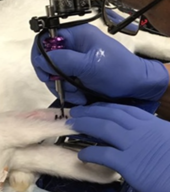Photomediated Ultrasound Therapy Method and Apparatus
TECHNOLOGY NUMBER: 7785

OVERVIEW
A novel photo acoustic cavitation to improve skin pigmentation removal- Combines light and sound to decrease energy required for laser therapy
- Lessens the number of required treatments and decreases complications
BACKGROUND
Skin pigmentation removal is useful for treatment of conditions such as nevi, vascular formations, or tumors. One common therapy for these conditions is laser treatment, which delivers high-energy pulses of light that heat one side of pigmented cells more rapidly than the other and causes them to burst, a process known as cavitation. The residual particles can subsequently be engulfed by phagocytes and processed by the immune system. However, laser treatment requires multiple sessions, may cause discomfort, and can lead to complications such as skin scarring, inflammation, or discoloration. One increasingly common scenario involves requests for tattoo removal by patients who come to regret their cosmetic decisions. In addition to the aforementioned limitations related to laser treatments, the removal of tattoos may require specific wavelengths dependent on the color of the ink in the tattoo, yielding greater difficulty in certain circumstances. So, a need exists for improvements in laser treatments for skin conditions and tattoo removal.
INNOVATION
Researchers have pioneered a means by which to use photoacoustic cavitation to improve skin pigmentation removal. The invention uses photo-mediated ultrasound to produce cavitation in pigmented cells. This approach therefore combines light and sound to decrease the amount of energy required for existing laser therapies, increasing the likelihood of cavitation while lessening the number of required treatments and decreasing the risk of complications. The higher percentage of pigment undergoing cavitation combined with a higher depth of photoacoustic penetration means that a single treatment session may be sufficient. In vivo data shows more than 50% removal of pigmentation within 28 days following a single treatment. This technology may therefore provide a successful intervention for a variety of clinical conditions.